Analyzing Social Factors in Indigenous Health Disparities: A Report
VerifiedAdded on 2022/08/18
|5
|1161
|17
Report
AI Summary
This report analyzes health disparities within Indigenous communities, particularly focusing on Aboriginal and Torres Strait Islander populations. It highlights the disproportionate burden of health problems, including chronic diseases and mental health issues, compared to non-Indigenous groups. The report emphasizes the social determinants of health, with a specific focus on access to healthcare as a significant factor influencing health outcomes. It discusses barriers such as the cost of services, remoteness, cultural and language gaps, and experiences of racism. The report references studies showing lower utilization of health services and the need for culturally appropriate care, as well as the importance of recruiting and retaining Indigenous health workers to improve trust and care experiences. It concludes by emphasizing that health disparities are preventable and that prioritizing Indigenous wellness is essential to empower the group in terms of health and social life.
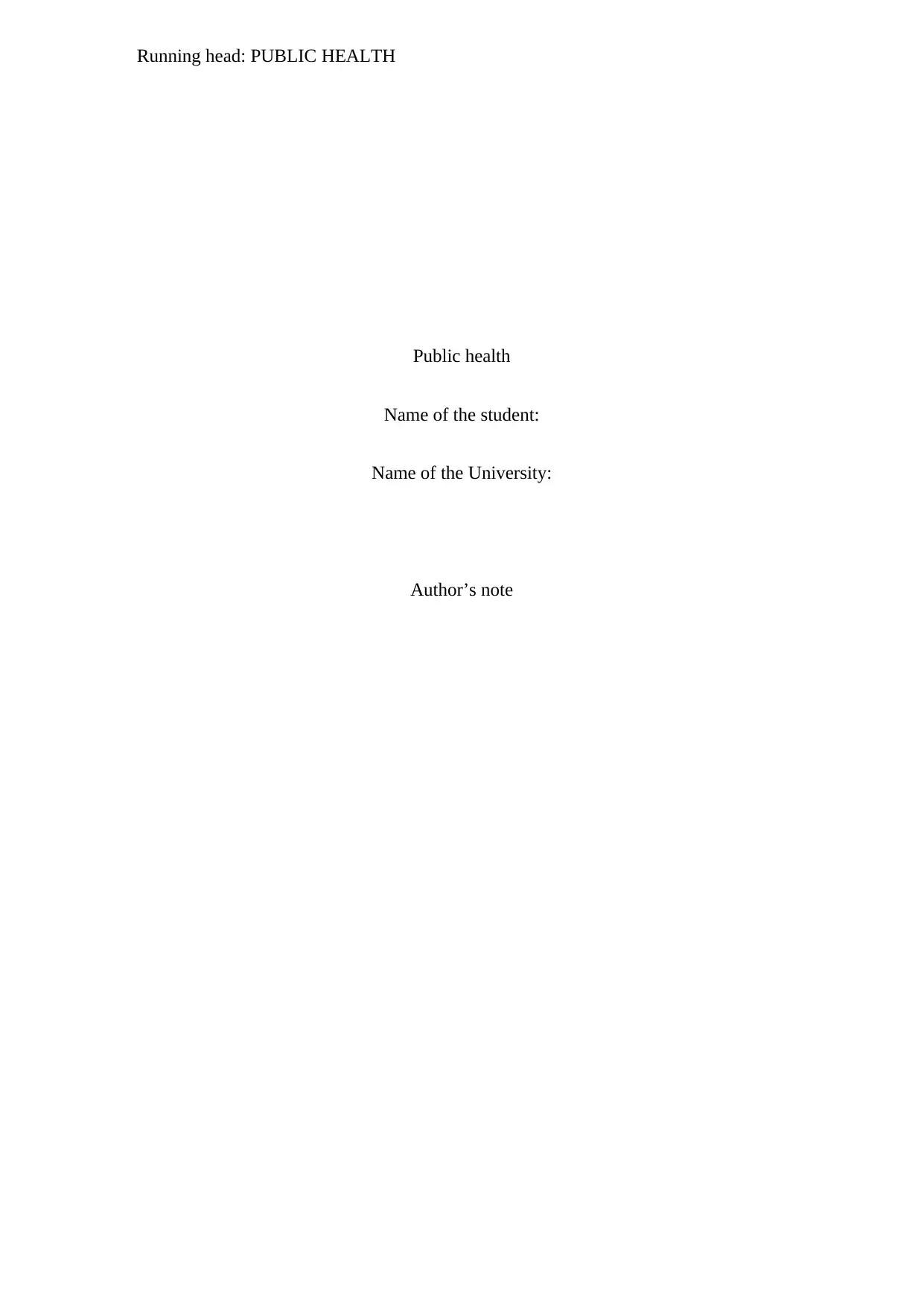
Running head: PUBLIC HEALTH
Public health
Name of the student:
Name of the University:
Author’s note
Public health
Name of the student:
Name of the University:
Author’s note
Paraphrase This Document
Need a fresh take? Get an instant paraphrase of this document with our AI Paraphraser
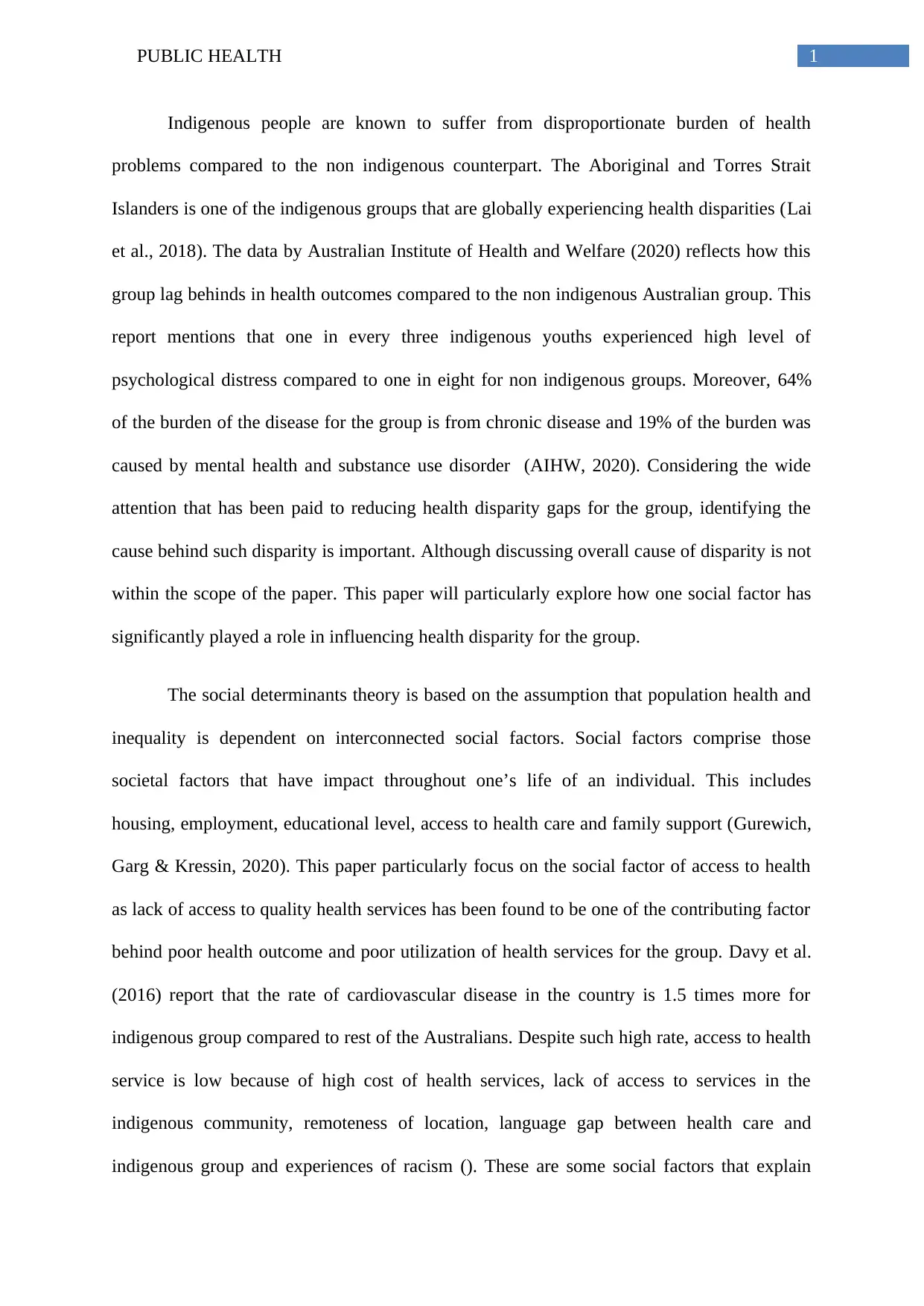
1PUBLIC HEALTH
Indigenous people are known to suffer from disproportionate burden of health
problems compared to the non indigenous counterpart. The Aboriginal and Torres Strait
Islanders is one of the indigenous groups that are globally experiencing health disparities (Lai
et al., 2018). The data by Australian Institute of Health and Welfare (2020) reflects how this
group lag behinds in health outcomes compared to the non indigenous Australian group. This
report mentions that one in every three indigenous youths experienced high level of
psychological distress compared to one in eight for non indigenous groups. Moreover, 64%
of the burden of the disease for the group is from chronic disease and 19% of the burden was
caused by mental health and substance use disorder (AIHW, 2020). Considering the wide
attention that has been paid to reducing health disparity gaps for the group, identifying the
cause behind such disparity is important. Although discussing overall cause of disparity is not
within the scope of the paper. This paper will particularly explore how one social factor has
significantly played a role in influencing health disparity for the group.
The social determinants theory is based on the assumption that population health and
inequality is dependent on interconnected social factors. Social factors comprise those
societal factors that have impact throughout one’s life of an individual. This includes
housing, employment, educational level, access to health care and family support (Gurewich,
Garg & Kressin, 2020). This paper particularly focus on the social factor of access to health
as lack of access to quality health services has been found to be one of the contributing factor
behind poor health outcome and poor utilization of health services for the group. Davy et al.
(2016) report that the rate of cardiovascular disease in the country is 1.5 times more for
indigenous group compared to rest of the Australians. Despite such high rate, access to health
service is low because of high cost of health services, lack of access to services in the
indigenous community, remoteness of location, language gap between health care and
indigenous group and experiences of racism (). These are some social factors that explain
Indigenous people are known to suffer from disproportionate burden of health
problems compared to the non indigenous counterpart. The Aboriginal and Torres Strait
Islanders is one of the indigenous groups that are globally experiencing health disparities (Lai
et al., 2018). The data by Australian Institute of Health and Welfare (2020) reflects how this
group lag behinds in health outcomes compared to the non indigenous Australian group. This
report mentions that one in every three indigenous youths experienced high level of
psychological distress compared to one in eight for non indigenous groups. Moreover, 64%
of the burden of the disease for the group is from chronic disease and 19% of the burden was
caused by mental health and substance use disorder (AIHW, 2020). Considering the wide
attention that has been paid to reducing health disparity gaps for the group, identifying the
cause behind such disparity is important. Although discussing overall cause of disparity is not
within the scope of the paper. This paper will particularly explore how one social factor has
significantly played a role in influencing health disparity for the group.
The social determinants theory is based on the assumption that population health and
inequality is dependent on interconnected social factors. Social factors comprise those
societal factors that have impact throughout one’s life of an individual. This includes
housing, employment, educational level, access to health care and family support (Gurewich,
Garg & Kressin, 2020). This paper particularly focus on the social factor of access to health
as lack of access to quality health services has been found to be one of the contributing factor
behind poor health outcome and poor utilization of health services for the group. Davy et al.
(2016) report that the rate of cardiovascular disease in the country is 1.5 times more for
indigenous group compared to rest of the Australians. Despite such high rate, access to health
service is low because of high cost of health services, lack of access to services in the
indigenous community, remoteness of location, language gap between health care and
indigenous group and experiences of racism (). These are some social factors that explain
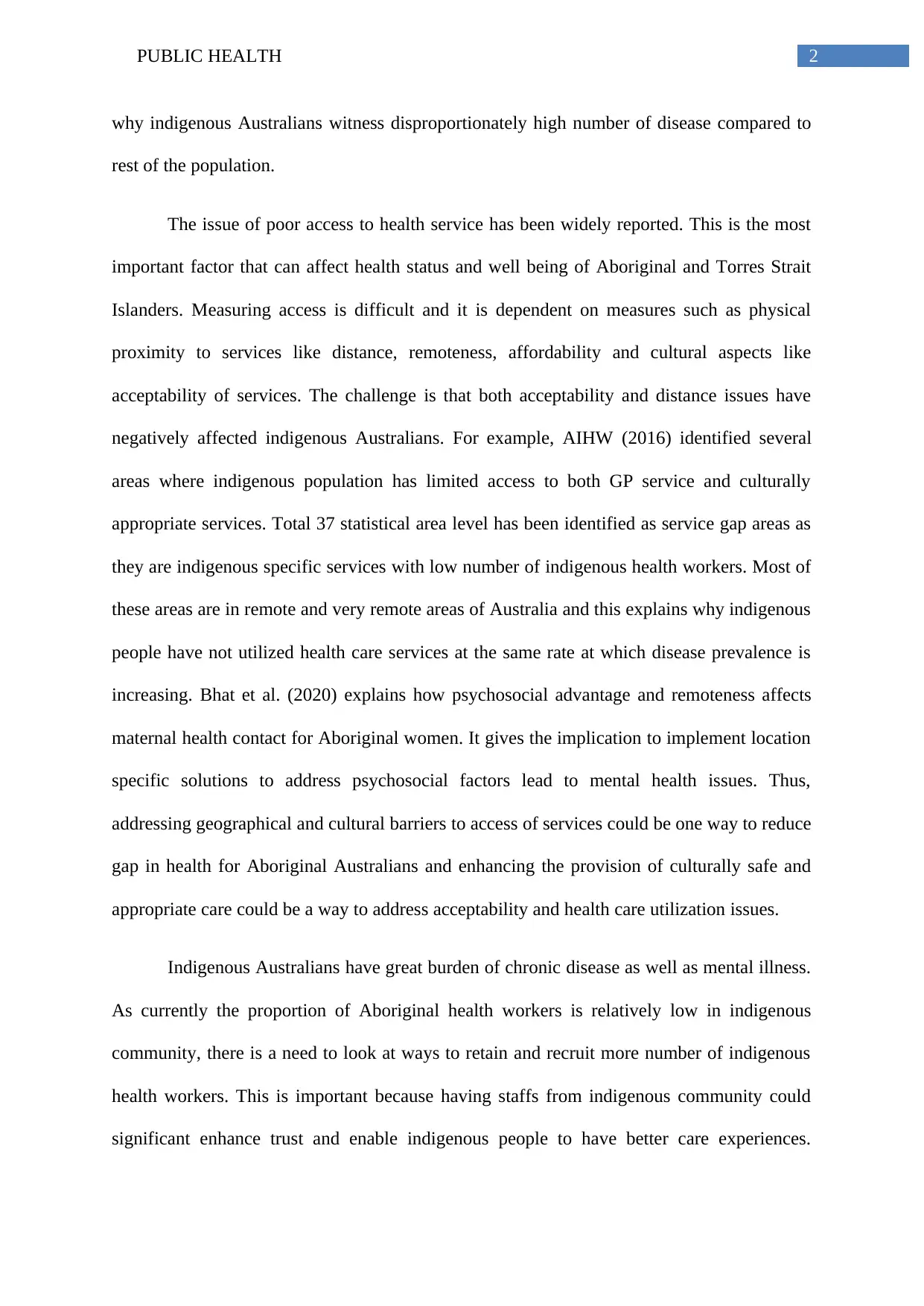
2PUBLIC HEALTH
why indigenous Australians witness disproportionately high number of disease compared to
rest of the population.
The issue of poor access to health service has been widely reported. This is the most
important factor that can affect health status and well being of Aboriginal and Torres Strait
Islanders. Measuring access is difficult and it is dependent on measures such as physical
proximity to services like distance, remoteness, affordability and cultural aspects like
acceptability of services. The challenge is that both acceptability and distance issues have
negatively affected indigenous Australians. For example, AIHW (2016) identified several
areas where indigenous population has limited access to both GP service and culturally
appropriate services. Total 37 statistical area level has been identified as service gap areas as
they are indigenous specific services with low number of indigenous health workers. Most of
these areas are in remote and very remote areas of Australia and this explains why indigenous
people have not utilized health care services at the same rate at which disease prevalence is
increasing. Bhat et al. (2020) explains how psychosocial advantage and remoteness affects
maternal health contact for Aboriginal women. It gives the implication to implement location
specific solutions to address psychosocial factors lead to mental health issues. Thus,
addressing geographical and cultural barriers to access of services could be one way to reduce
gap in health for Aboriginal Australians and enhancing the provision of culturally safe and
appropriate care could be a way to address acceptability and health care utilization issues.
Indigenous Australians have great burden of chronic disease as well as mental illness.
As currently the proportion of Aboriginal health workers is relatively low in indigenous
community, there is a need to look at ways to retain and recruit more number of indigenous
health workers. This is important because having staffs from indigenous community could
significant enhance trust and enable indigenous people to have better care experiences.
why indigenous Australians witness disproportionately high number of disease compared to
rest of the population.
The issue of poor access to health service has been widely reported. This is the most
important factor that can affect health status and well being of Aboriginal and Torres Strait
Islanders. Measuring access is difficult and it is dependent on measures such as physical
proximity to services like distance, remoteness, affordability and cultural aspects like
acceptability of services. The challenge is that both acceptability and distance issues have
negatively affected indigenous Australians. For example, AIHW (2016) identified several
areas where indigenous population has limited access to both GP service and culturally
appropriate services. Total 37 statistical area level has been identified as service gap areas as
they are indigenous specific services with low number of indigenous health workers. Most of
these areas are in remote and very remote areas of Australia and this explains why indigenous
people have not utilized health care services at the same rate at which disease prevalence is
increasing. Bhat et al. (2020) explains how psychosocial advantage and remoteness affects
maternal health contact for Aboriginal women. It gives the implication to implement location
specific solutions to address psychosocial factors lead to mental health issues. Thus,
addressing geographical and cultural barriers to access of services could be one way to reduce
gap in health for Aboriginal Australians and enhancing the provision of culturally safe and
appropriate care could be a way to address acceptability and health care utilization issues.
Indigenous Australians have great burden of chronic disease as well as mental illness.
As currently the proportion of Aboriginal health workers is relatively low in indigenous
community, there is a need to look at ways to retain and recruit more number of indigenous
health workers. This is important because having staffs from indigenous community could
significant enhance trust and enable indigenous people to have better care experiences.
⊘ This is a preview!⊘
Do you want full access?
Subscribe today to unlock all pages.

Trusted by 1+ million students worldwide
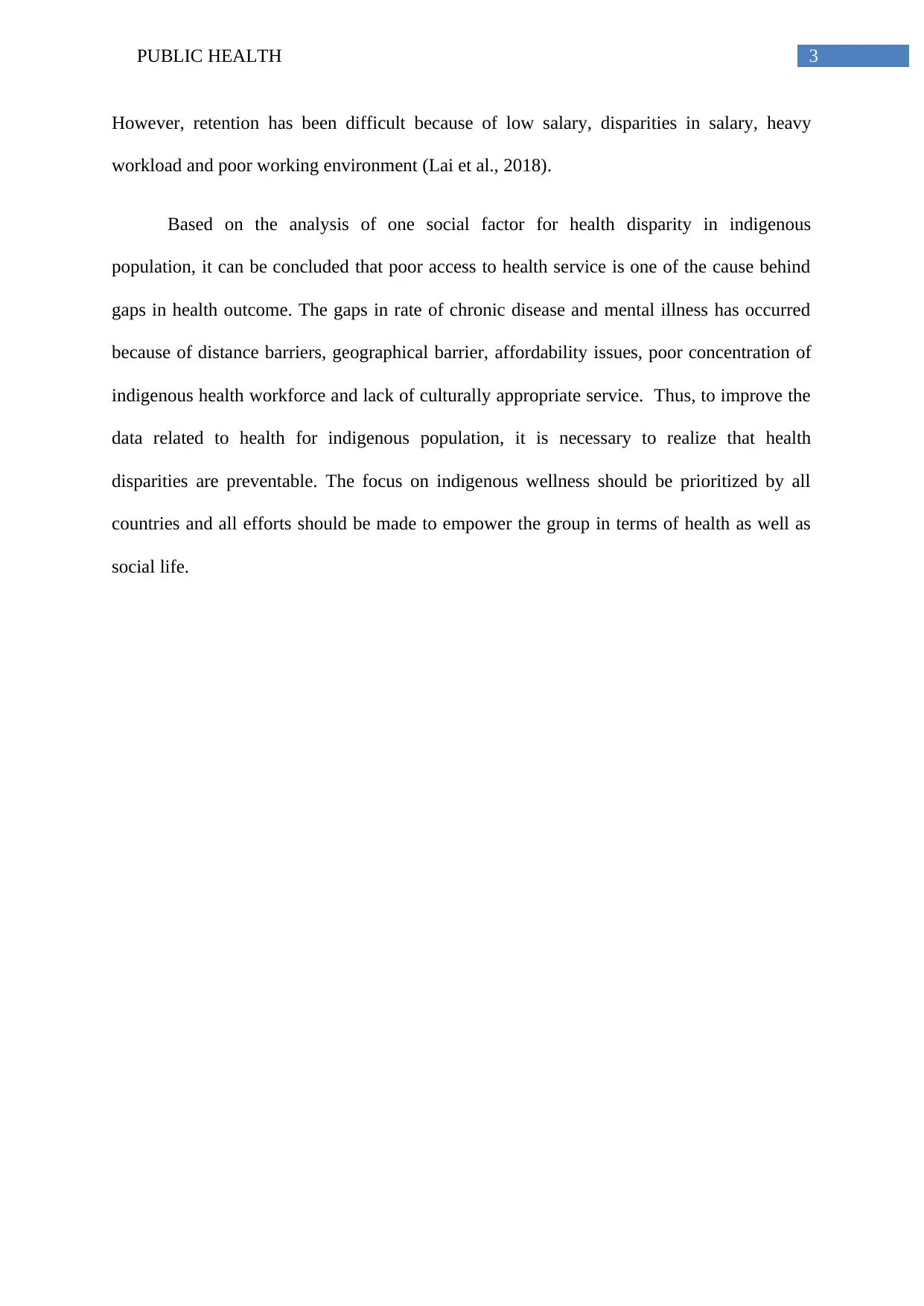
3PUBLIC HEALTH
However, retention has been difficult because of low salary, disparities in salary, heavy
workload and poor working environment (Lai et al., 2018).
Based on the analysis of one social factor for health disparity in indigenous
population, it can be concluded that poor access to health service is one of the cause behind
gaps in health outcome. The gaps in rate of chronic disease and mental illness has occurred
because of distance barriers, geographical barrier, affordability issues, poor concentration of
indigenous health workforce and lack of culturally appropriate service. Thus, to improve the
data related to health for indigenous population, it is necessary to realize that health
disparities are preventable. The focus on indigenous wellness should be prioritized by all
countries and all efforts should be made to empower the group in terms of health as well as
social life.
However, retention has been difficult because of low salary, disparities in salary, heavy
workload and poor working environment (Lai et al., 2018).
Based on the analysis of one social factor for health disparity in indigenous
population, it can be concluded that poor access to health service is one of the cause behind
gaps in health outcome. The gaps in rate of chronic disease and mental illness has occurred
because of distance barriers, geographical barrier, affordability issues, poor concentration of
indigenous health workforce and lack of culturally appropriate service. Thus, to improve the
data related to health for indigenous population, it is necessary to realize that health
disparities are preventable. The focus on indigenous wellness should be prioritized by all
countries and all efforts should be made to empower the group in terms of health as well as
social life.
Paraphrase This Document
Need a fresh take? Get an instant paraphrase of this document with our AI Paraphraser
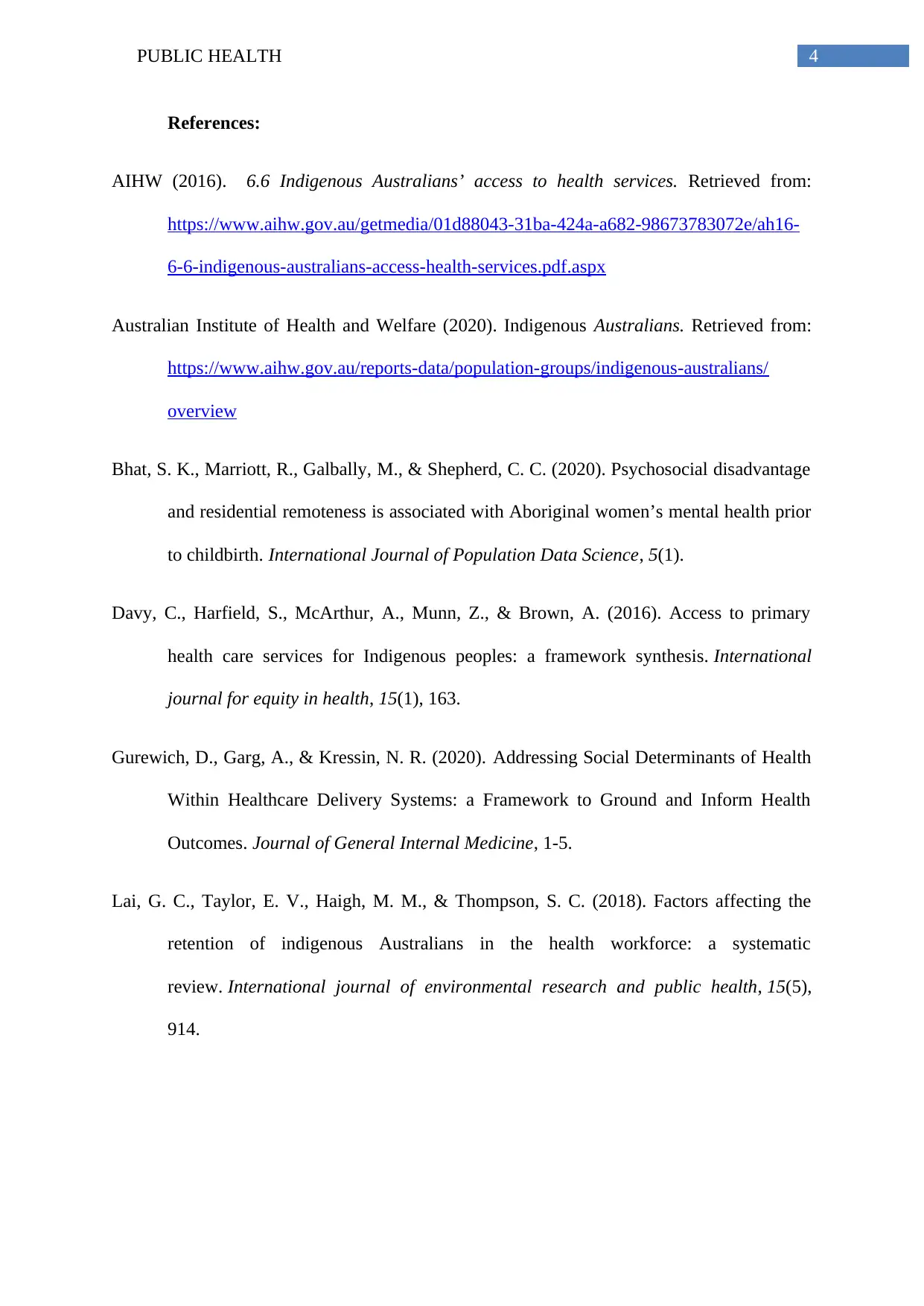
4PUBLIC HEALTH
References:
AIHW (2016). 6.6 Indigenous Australians’ access to health services. Retrieved from:
https://www.aihw.gov.au/getmedia/01d88043-31ba-424a-a682-98673783072e/ah16-
6-6-indigenous-australians-access-health-services.pdf.aspx
Australian Institute of Health and Welfare (2020). Indigenous Australians. Retrieved from:
https://www.aihw.gov.au/reports-data/population-groups/indigenous-australians/
overview
Bhat, S. K., Marriott, R., Galbally, M., & Shepherd, C. C. (2020). Psychosocial disadvantage
and residential remoteness is associated with Aboriginal women’s mental health prior
to childbirth. International Journal of Population Data Science, 5(1).
Davy, C., Harfield, S., McArthur, A., Munn, Z., & Brown, A. (2016). Access to primary
health care services for Indigenous peoples: a framework synthesis. International
journal for equity in health, 15(1), 163.
Gurewich, D., Garg, A., & Kressin, N. R. (2020). Addressing Social Determinants of Health
Within Healthcare Delivery Systems: a Framework to Ground and Inform Health
Outcomes. Journal of General Internal Medicine, 1-5.
Lai, G. C., Taylor, E. V., Haigh, M. M., & Thompson, S. C. (2018). Factors affecting the
retention of indigenous Australians in the health workforce: a systematic
review. International journal of environmental research and public health, 15(5),
914.
References:
AIHW (2016). 6.6 Indigenous Australians’ access to health services. Retrieved from:
https://www.aihw.gov.au/getmedia/01d88043-31ba-424a-a682-98673783072e/ah16-
6-6-indigenous-australians-access-health-services.pdf.aspx
Australian Institute of Health and Welfare (2020). Indigenous Australians. Retrieved from:
https://www.aihw.gov.au/reports-data/population-groups/indigenous-australians/
overview
Bhat, S. K., Marriott, R., Galbally, M., & Shepherd, C. C. (2020). Psychosocial disadvantage
and residential remoteness is associated with Aboriginal women’s mental health prior
to childbirth. International Journal of Population Data Science, 5(1).
Davy, C., Harfield, S., McArthur, A., Munn, Z., & Brown, A. (2016). Access to primary
health care services for Indigenous peoples: a framework synthesis. International
journal for equity in health, 15(1), 163.
Gurewich, D., Garg, A., & Kressin, N. R. (2020). Addressing Social Determinants of Health
Within Healthcare Delivery Systems: a Framework to Ground and Inform Health
Outcomes. Journal of General Internal Medicine, 1-5.
Lai, G. C., Taylor, E. V., Haigh, M. M., & Thompson, S. C. (2018). Factors affecting the
retention of indigenous Australians in the health workforce: a systematic
review. International journal of environmental research and public health, 15(5),
914.
1 out of 5
Related Documents
Your All-in-One AI-Powered Toolkit for Academic Success.
+13062052269
info@desklib.com
Available 24*7 on WhatsApp / Email
![[object Object]](/_next/static/media/star-bottom.7253800d.svg)
Unlock your academic potential
Copyright © 2020–2025 A2Z Services. All Rights Reserved. Developed and managed by ZUCOL.





